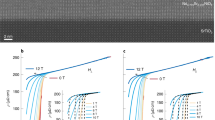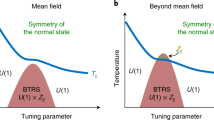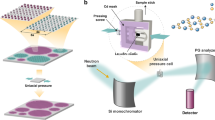Abstract
There is still no universally accepted theory of high-temperature superconductivity. Most models assume that doping creates ‘holes’ in the valence band of an insulating, antiferromagnetic ‘parent’ compound, and that antiferromagnetism and high-temperature superconductivity are intimately related1,2,3,4,5,6,7,8. If their respective energies are nearly equal, strong antiferromagnetic fluctuations (temporally and spatially restricted antiferromagnetic domains) would be expected in the superconductive phase, and superconducting fluctuations would be expected in the antiferromagnetic phase7; the two states should ‘mix’ over an extended length scale8. Here we report that one-unit-cell-thick antiferromagnetic La2CuO4 barrier layers remain highly insulating and completely block a supercurrent; the characteristic decay length is 1 Å, indicating that the two phases do not mix. We likewise found that isolated one-unit-cell-thick layers of La1.85Sr0.15CuO4 remain superconducting. The latter further implies that, on doping, new electronic states are created near the middle of the bandgap. These two findings are in conflict with most proposed models, with a few notable exceptions that include postulated spin–charge separation2.
This is a preview of subscription content, access via your institution
Access options
Subscribe to this journal
Receive 51 print issues and online access
$199.00 per year
only $3.90 per issue
Buy this article
- Purchase on Springer Link
- Instant access to full article PDF
Prices may be subject to local taxes which are calculated during checkout



Similar content being viewed by others
References
Anderson, P. W. The Theory of Superconductivity in the High-Tc Cuprate Superconductors (Princeton Univ. Press, Princeton, 1997)
Anderson, P. W. Spin-charge separation is the key to the high Tc cuprates. Physica C 341–348, 9–10 (2000)
Kivelson, S. A., Rokhsar, D. S. & Sethna, J. P. Topology of the resonating valence-bond state: Solitons and high-Tc superconductivity. Phys. Rev. B 35, 8865–8868 (1987)
Zaanen, J. & Gunnarsson, O. Charged magnetic domain lines and the magnetism of high-Tc oxides. Phys. Rev. B 40, 7391–7394 (1989)
Fisher, D. S., Kotliar, G. & Moeller, G. Midgap states in doped Mott insulators in infinite dimensions. Phys. Rev. B 52, 17112–17118 (1995)
Kampf, A. & Schrieffer, J. R. Pseudogaps and the spin-bag approach to high-Tc superconductivity. Phys. Rev. B 41, 6399–6408 (1990)
Zhang, S. C. A unified theory based on SO(5) symmetry of superconductivity and antiferromagnetism. Science 275, 1089–1096 (1997)
Demler, E., Berlinsky, A. J., Kallin, C., Arnold, G. B. & Beasley, M. R. Proximity effect and Josephson coupling in the SO(5) theory of high-Tc superconductivity. Phys. Rev. Lett. 80, 2917–2920 (1998)
Bozovic, I. Atomic-layer engineering of superconducting oxides: Yesterday, today, tomorrow. IEEE Trans. Appl. Supercond. 11, 2686–2695 (2001)
Bozovic, I., Logvenov, G., Belca, I., Narimbetov, B. & Sveklo, I. Epitaxial strain and superconductivity in La2-xSrxCuO4 thin films. Phys. Rev. Lett. 89, 100700 (2002)
Golubov, A. A. et al. Resonant tunneling in Y(Dy)Ba2Cu3O7-δ/PrBa2Cu3-xGaxO7-δ/Y(Dy)Ba2Cu3O7-δ ramp-type Josephson junctions. Physica C 235–240, 3261–3262 (1994)
Bozovic, I. & Eckstein, J. N. Transport in atomically engineered BiSrCaCuO multilayers. J. Supercond. 8, 537–540 (1995)
Wolf, E. L. Principles of Electron Tunneling Spectroscopy 36–45 (Oxford Univ. Press, Oxford, 1989)
Bozovic, I., Eckstein, J. N., Klausmeier-Brown, M. E. & Virshup, G. F. Superconductivity in epitaxial Bi2Sr2CuO6/Bi2Sr2CaCu2O8 superlattices: The superconducting behavior of ultrathin cuprate slabs. J. Supercond. 5, 19–23 (1992)
Thio, T., Birgeneau, R. J., Cassanho, A. & Kastner, M. A. Determination of the energy gap for charged excitations in insulating La2CuO4 . Phys. Rev. B 42, 10800–10803 (1990)
Uchida, S. et al. Optical spectra of La2-xSrxCuO4: Effect of carrier doping on the electronic structure of the CuO2 plane. Phys. Rev. B 43, 7942–7954 (1991)
Kirillov, D., Bozovic, I., Char, K. & Kapitulnik, A. Resonance effects in Raman scattering in YBa2Cu3O7 . J. Appl. Phys. 66, 977–979 (1989)
Gor'kov, L. P. & Sokol, A. V. Phase stratification of an electron liquid in the new superconductors. JETP Lett. 46, 420–423 (1987)
Emery, V. J. & Kivelson, S. A. Frustrated electronic phase separation and high-temperature superconductors. Physica C 209, 597–621 (1993)
Alexandrov, A. S. & Mott, N. Polarons and Bipolarons (World Scientific, Singapore, 1995)
Varma, C. M., Littlewood, P. B., Schmitt–Rink, S., Abrahams, E. & Ruckenstein, A. E. Phenomenology of the normal state of Cu-O high-temperature superconductors. Phys. Rev. Lett. 63, 1996–1999 (1989); erratum: Phys. Rev. Lett. 64, 497 (1990)
Ando, Y., Boebinger, G. S., Passner, A., Kimura, T. & Kishio, K. Logarithmic divergence of both in-plane and out-of-plane normal-state resistivities of superconducting La2-xSrxCuO4 in the zero-temperature limit. Phys. Rev. Lett. 75, 4662–4665 (1995)
Anderson, P. W. & Zou, Z. “Normal” tunneling and “normal” transport: Diagnostics for the resonating-valence-bond state. Phys. Rev. Lett. 60, 132–135 (1988)
Acknowledgements
We acknowledge discussions with M. R. Beasley, A. Leggett, G. A. Sawatzky, S. Kivelson, A. Tsvelik, P. Stamp, S. C. Zhang, A. Kleinsasser, A. Abrikosov, A. Millis, R. Dynes and S. Chakraverty. We thank I. Sveklo, B. Narimbetov and I. Belca for technical help. This work was supported in part by AFOSR.
Author information
Authors and Affiliations
Corresponding author
Ethics declarations
Competing interests
The authors declare that they have no competing financial interests.
Rights and permissions
About this article
Cite this article
Bozovic, I., Logvenov, G., Verhoeven, M. et al. No mixing of superconductivity and antiferromagnetism in a high-temperature superconductor. Nature 422, 873–875 (2003). https://doi.org/10.1038/nature01544
Received:
Accepted:
Issue Date:
DOI: https://doi.org/10.1038/nature01544
This article is cited by
-
The Quest for High(er) Tc in BaBiO3-Based Heterostructures
Journal of Superconductivity and Novel Magnetism (2020)
-
Angle-Resolved Transport Measurements Reveal Electronic Nematicity in Cuprate Superconductors
Journal of Superconductivity and Novel Magnetism (2020)
-
Fermion dynamical symmetry and strongly-correlated electrons: A comprehensive model of high-temperature superconductivity
Frontiers of Physics (2020)
-
Electron pairing in the pseudogap state revealed by shot noise in copper oxide junctions
Nature (2019)
-
A Model of Competing Orders and Its Application to a Novel Junction
Journal of Superconductivity and Novel Magnetism (2019)
Comments
By submitting a comment you agree to abide by our Terms and Community Guidelines. If you find something abusive or that does not comply with our terms or guidelines please flag it as inappropriate.



